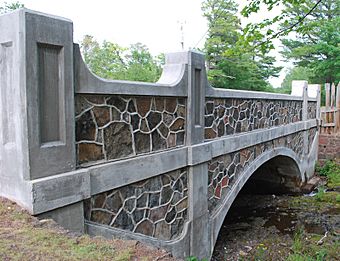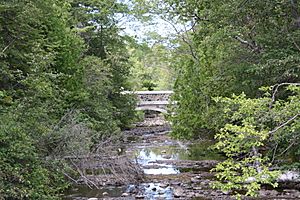US 41–Fanny Hooe Creek Bridge facts for kids
Quick facts for kids |
|
|
US 41–Fanny Hooe Creek Bridge
|
|
 |
|
| Location | |
|---|---|
| Built | 1928 |
| Architect | Keweenaw County Road Commission; Michigan State Highway Dept. |
| Architectural style | Spandrel arch bridge |
| MPS | Highway Bridges of Michigan MPS |
| NRHP reference No. | 99001525 |
| Added to NRHP | December 17, 1999 |
The US 41–Fanny Hooe Creek Bridge is a special bridge in Michigan. It carries US Highway 41 over a small stream called Fanny Hooe Creek. You can find it near Copper Harbor and Fort Wilkins State Park in Grant Township. This bridge is important because it was added to the National Register of Historic Places in 1999. This means it's a historic landmark worth protecting!
Contents
Building the Bridge: A Look at Its History
Have you ever wondered how old roads and bridges were built? In 1913, Michigan passed a law called the State Trunk Line Act. This law helped create a main road system across the state. Parts of this new road system later became what we know today as US 41 and US 45.
Improving Roads in the 1920s
During the 1920s, many parts of these main roads were made better. Workers smoothed out the ground and built new bridges. The Fanny Hooe Creek Bridge was one of these new bridges. It was built by the Keweenaw County Road Commission. This group also built other bridges around the same time. The bridge cost about $8,132 to build back then. That was a lot of money!
What Makes the Fanny Hooe Creek Bridge Special?
The Fanny Hooe Creek Bridge is a type of bridge called a concrete arch bridge. It's not very long, spanning only 25 feet across the creek. It has a rounded, arch shape and a strong concrete base.
Unique Stone Design and Craftsmanship
What really makes this bridge stand out is its beautiful stonework. The walls and railings of the bridge are decorated with fieldstones. These stones are carefully placed with a special kind of mortar that looks like grapevine patterns. This decorative stonework is quite rare for bridges in Michigan. It shows amazing skill from the people who built it. An engineer named George Tramp, who worked for the Michigan State Highway Department in the 1920s, was very impressed. He said that seeing the stonework on this bridge proved that the art of stone masonry was still alive!




